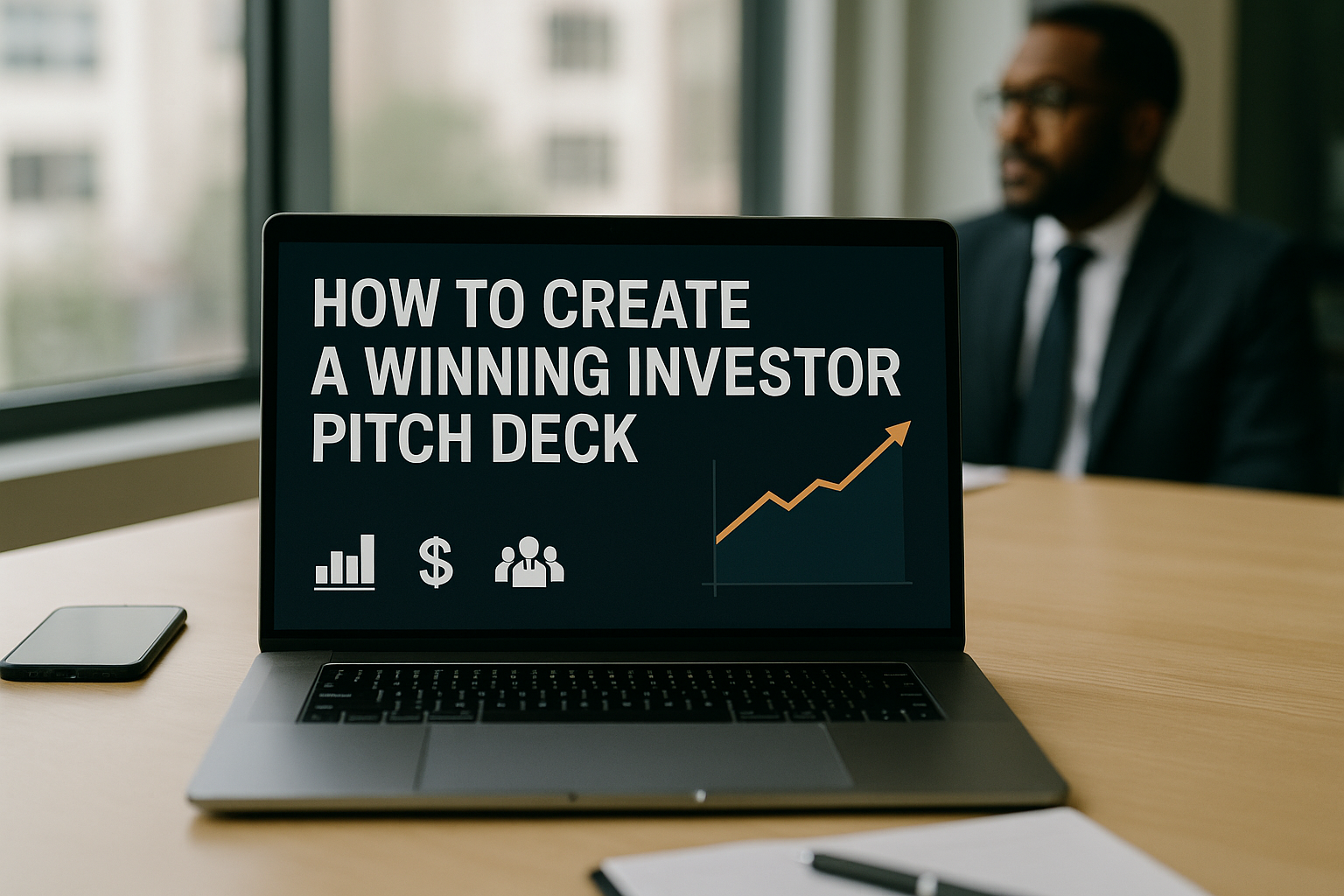If you’re preparing to pitch, learning how to create a winning investor pitch deck can make the difference between getting a polite “no” and securing the funding you need. Your pitch deck is often your first impression with potential investors — and it needs to tell a compelling story that captures attention, builds trust, and inspires action.
Quick Answer: A winning investor pitch deck is concise (10–15 slides), visually clear, and tells a story that covers your problem, solution, market opportunity, traction, business model, and team — while making a strong case for why now is the time to invest.
This guide breaks down exactly how to create an investor pitch deck that stands out, engages, and gets you funded.
1. First Step to Creating a Winning Pitch Deck : Start with a Powerful Cover Slide
Your first slide sets the tone. Include:
- Company name & logo
- Tagline that communicates your value proposition
- A strong visual or image that reinforces your brand or problem space
The opening slide should make investors curious enough to want to learn more — it’s your “hook.” Think of it like the movie poster for your startup.
2. Define the Problem Clearly
Investors back solutions to real problems. Use this slide in your pitch deck to:
- State the problem in simple, relatable terms
- Use a compelling stat or story to show urgency
- Highlight who is affected and the cost of doing nothing
Avoid being vague — clearly quantify the pain point. If you can’t articulate it in one sentence, you don’t understand it well enough yet.
According to Harvard Business Review, clearly defining a business problem not only frames your pitch but also establishes credibility with potential investors.
3. Present Your Solution
Show how your product or service solves the problem better than anything else on the market.
Include:
- Core features & benefits
- Why it’s different from competitors
- A short demo screenshot or mockup
Investors are buying into your vision, not just your current product. Show where it’s heading, not just where it is now.
4. Show Market Opportunity
A great product is not enough — you need a big, growing market.
- Total Addressable Market (TAM)
- Serviceable Addressable Market (SAM)
- Serviceable Obtainable Market (SOM)
- Evidence of industry growth trends
A small but fast-growing niche can be more attractive than a massive stagnant market. Show your growth potential.
5. Highlight Traction
Prove you can execute. Use:
- Revenue numbers or user growth
- Partnerships or pilot programs
- Key milestones achieved to date
Early traction doesn’t have to be huge — even small wins can validate your ability to deliver.
6. Explain Your Business Model
Investors want to know how you make money. Show:
- Pricing structure
- Revenue streams
- Customer acquisition channels
Keep it simple. If your model is too complex to explain quickly, investors may see it as risky.
7. Showcase Your Go-to-Market Strategy
Outline your plan to scale:
- Marketing channels
- Sales process
- Partnership strategies
8. Introduce Your Team
Investors invest in people first. Include:
- Founders and leadership bios with relevant experience
- Key advisors or investors already onboard
Highlight why your team is uniquely qualified to win in this market — not just their job titles.
9. Detail the Ask
Be clear about:
- How much you’re raising
- How funds will be allocated
- What milestones you’ll achieve with this capital
Tie your ask directly to outcomes — e.g., “With $500k, we’ll launch in 3 new markets and reach $1M ARR within 18 months.”
10. Close with a Strong Summary Slide
Reinforce why your business is a great investment. Include your:
- Vision statement
- Contact information
- Call to action for next steps
Common Mistakes to Avoid
- Overloading slides with text
- Using unclear or outdated data
- Skipping the “ask” slide
- Making the deck too long (stick to 10–15 slides)
By following these steps, you’ll know exactly how to create a winning pitch deck that captures investor attention.
If you’re also working on your credibility before pitching, check our guide on how to build investor trust -it’s the foundation that makes your pitch deck far more compelling.
FAQs
Q: How many slides should an investor pitch deck have?
A: 10–15 slides is ideal for keeping investors engaged while covering all key points.
Q: Should I customize my pitch deck for each investor?
A: Yes — tailor your deck to highlight areas that align with each investor’s focus or portfolio.
Q: Do I need a designer for my pitch deck?
A: Not necessarily, but a visually polished deck helps convey professionalism and credibility.





 Book a Call
Book a Call
